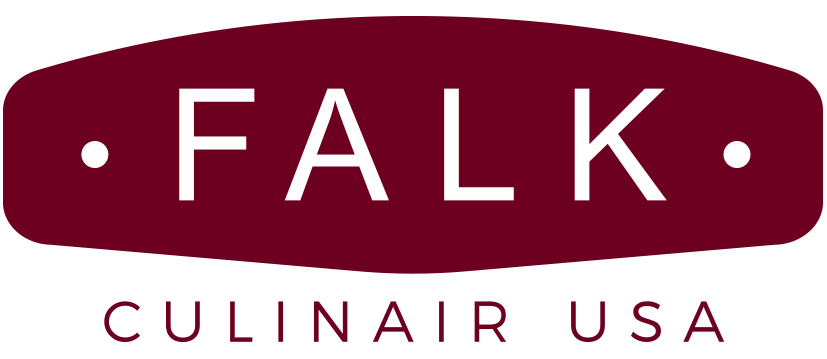Cleaning Falk Copper Cookware
Falk Culinair's copper and stainless steel surfaces have been brushed to create a satinated surface as opposed to a mirror finish like other brands. What this does is reduce the work necessary to keep your cookware glowing like new. For general cleaning after cooking, washing by hand in warm soapy water is normally all you will need. For baked on food debris, soak in hot soapy water for an hour then wash as usual. That's all that's needed to lift away even stubborn cooked on foods. If you wish, you may season the stainless steel interior of the pan. However, this is not necessary.
Copper will react with the atmosphere, causing a brownish tint on the surface of your pan. This oxidation is a natural phenomenon due to the way carbon dioxide in the air interacts with the metal. This is referred to as patina and is actually prized and preferred by many professional chefs and cooking enthusiasts. This darkening of the copper on your cookware or other copper household items does not mean the copper is wearing off or that something is wrong. It does not affect the cooking experience or performance of the cookware. It is an aesthetic preference only. To remove the patina, use a scrubbing pad and a cleaning paste intended for copper.
Your Falk Culinair cookware is designed and handcrafted to last a lifetime. By observing a few practical care procedures, it will serve you and your family indefinitely.
Do's and Don'ts
- Never submerge your beautiful copper cookware in water for extended periods of time. The cast iron handle will rust if left to soak in water and the copper will become tarnished. Instead, pour hot water into the vessel and add dish washing liquid. Let this soak inside of the cookware while you enjoy your meal and the cleanup should be simple when the meal is done.
- Avoid pitting and marking the stainless steel interior by stirring in salt, don't let it sink to the bottom. Add salt to boiling or simmering water and stir until dissolved.
- We recommend the use of wooden or plastic utensils. Sharp metal utensils can mark your cookware.
- Use hot water in hot cookware when cleaning, as cold water in a hot vessel can cause the metal to warp.
- Match your pot or pan to the right size burner, especially on gas ranges. The flames can lick the sides of your vessel during cooking if you put it on a burner which is too large. This will cause marks as well as overheating the vessel. Remember, copper conducts heat more efficiently than other metals, it's important to use slightly lower heat settings than normal. This will avoid unnecessary scorching and reduce the cleanup work involved.
- Keep an eye on simmering liquids and foods- never allow the fluid to boil dry. This is the quickest way to damage all cookware. Not to mention ruining a decent meal!
- Never use harsh chemicals or chlorine-based products to clean your copper. Use dish washing liquid and, when desired, a polish intended for copper.
- Wire wool and other metal-based scrubbers are not suitable for cleaning your beautiful copper cookware as these can etch the brushed texture of the stainless steel and copper. A rigid plastic scraper can be useful in removing stubborn food debris like scrambled eggs. Then follow up with a scrubbing pad or sponge.
- Always dry your cookware thoroughly after cleaning.
- After washing and drying, a periodic polish with olive oil on the cast iron handle will keep it looking great.
- The dishwasher is not suitable for copper of any kind as the detergents and salts will tarnish, etch and corrode the copper.













